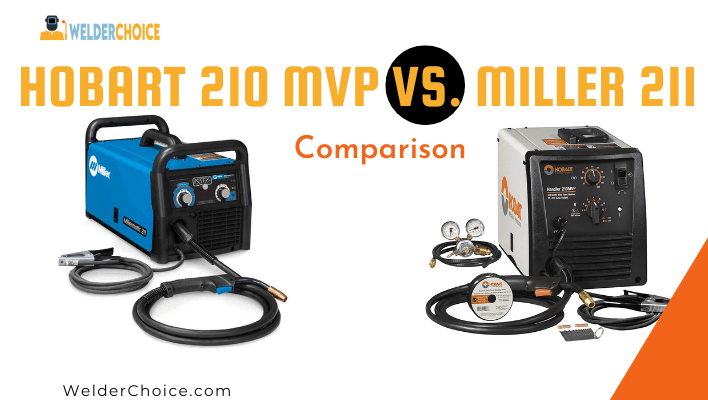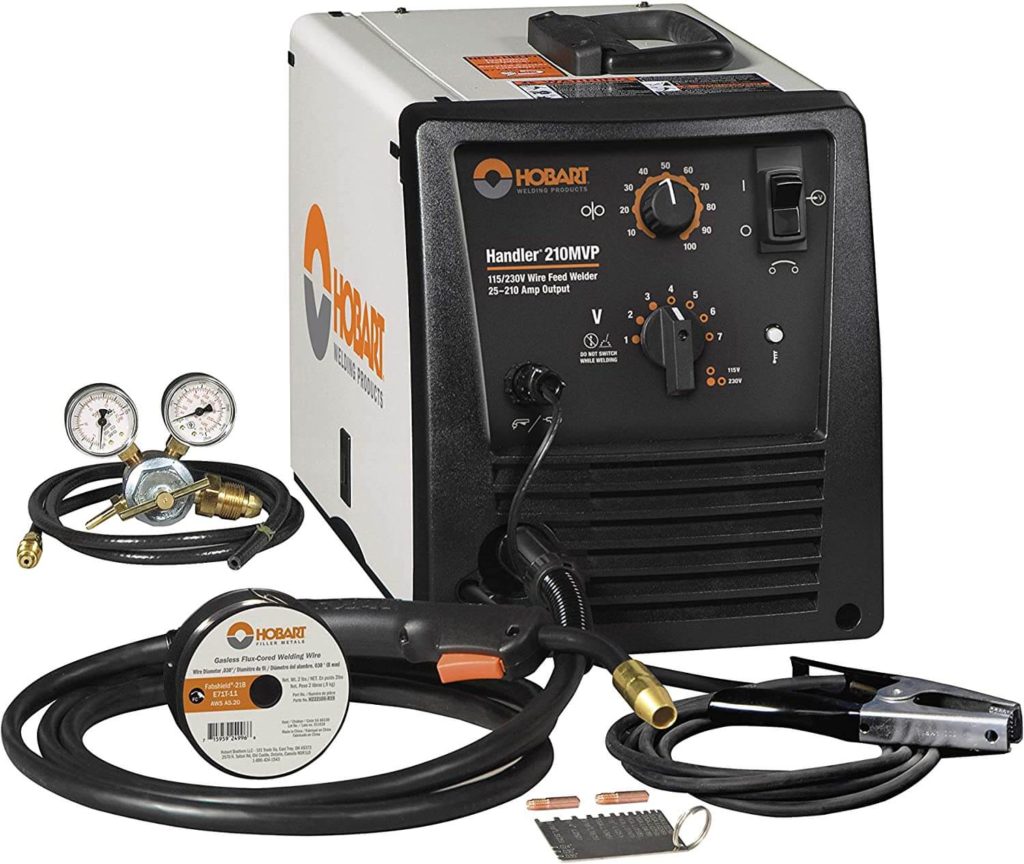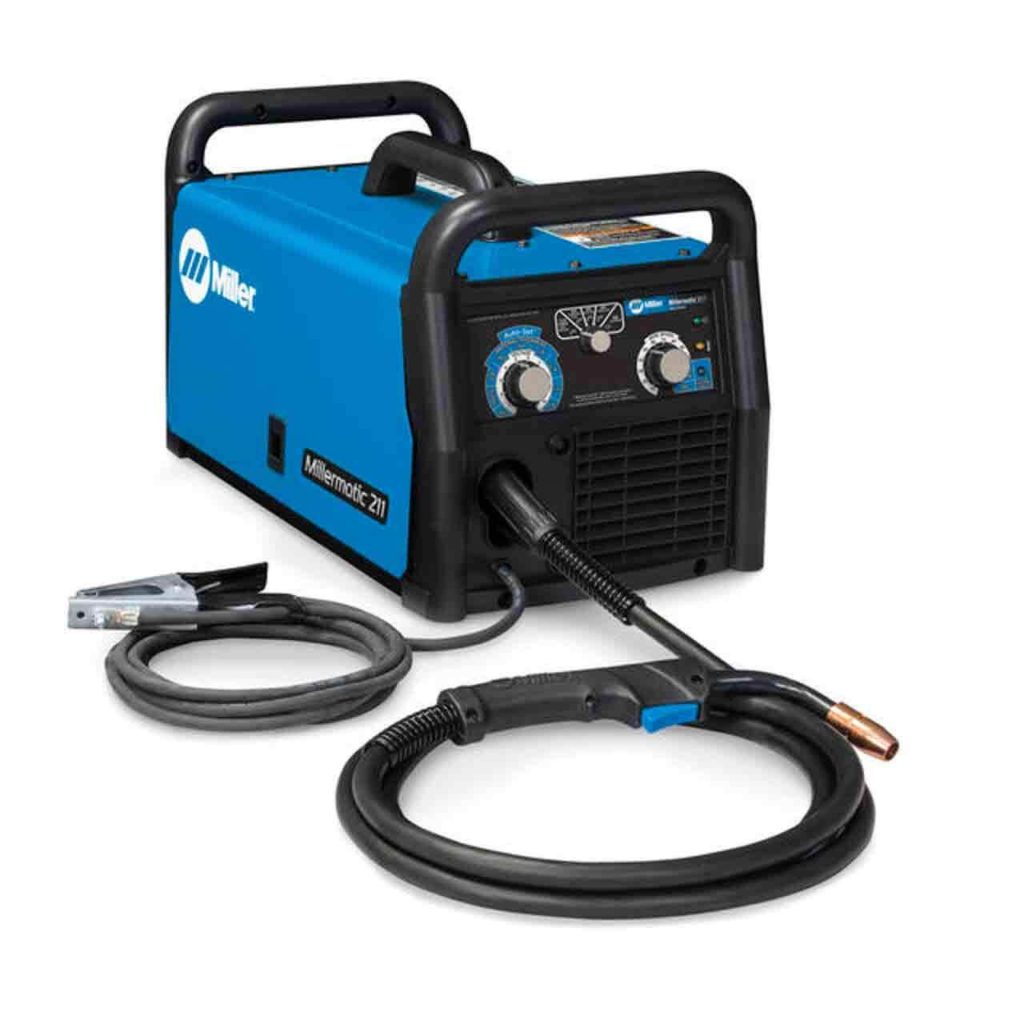Comparison of the Hobart 210 MVP Vs. Miller 211 when looking for welding equipment. When it comes to welding equipment, both of these franchises are at the top in welding products.
Most MIG welders are portable and can handle a variety of tasks. These two brands compete head-to-head with their machines in all types of work, whether it be “At Home” DIY projects, hobby projects, or industrial work. This is precisely the situation with Miler 211 and Hobart 210 MVP.
An astounding number of features are present in each of these devices. The Hobart 210 offers you a variety of alternative accessories as well as quick welding capabilities. Miller counters that by automatically detecting spool guns and using the “AutoSet” feature.
Which of these tools, though, is the greatest when it comes to optimizing and saving money while placing performance first? In my comparison essay between the Hobart 210 and Miller 211, I’ll be looking for an answer to this question. Let’s get to the point of the piece without further ado.
Comparing the Two Competing Devices in Detail Reviews
Let me be honest with you: Until we investigate both machines, we cannot compare the two in the issue. Before moving on to finding parallels and actual areas of comparison, we must first briefly summarise the advantages that each of the machines offers in an individual, succinct review. So let’s do that in the following section while wearing our reading glasses or contact lenses.
Hobart Handler 210 MVP MIG Welder Reviews
Let me clear up a little issue before I go into the meat of the article. The welding industry refers to this little welder’s plug as “An MVP Plug” or a “Multi-Voltage Plug” This enables the welder to operate in 115V and 230V environments and conditions.
Do you understand what this means? Both inside and outside the USA, people can use it. Users won’t need to create a brand-new electric system or purchase an additional converter in order to use it.
You’ll have a tonne of choices if you choose to purchase this item online. You can choose to purchase the machine’s main component alone or in combination with tools like pliers and welding gel. However, be ready to spend some extra money. We’ll soon discover why it’s one of the best offers available, in any case.
The machine’s lack of clutter on the control panel is something I found appealing. Even novices may understand everything because of how well it is written up and how to use it.
Onboard controls include an On/Off switch, a knob to control voltage, another to control amp count, and a temperature gauge. I enjoyed adjusting my welding performance with as many as seven different voltage levels. To further avoid mishaps, the power cord is encased.
There are 12 multipurpose pliers included in the package if someone purchases it with pliers. With all of these add-ons, the Hobart Handler 210 can handle amps in the range of 25 and 210. This comes in useful when we utilize the machine for home DIY projects and little heavy lifting.
What sort of materials and how much can we weld with it, then? It turns out that this device can weld aluminum, stainless steel, and regular steel. You ask, up to what thickness? This tool can weld materials that are 24 ga. and up to 3/8 in. thick.
Before I forget, I should point out that the Hobart 210 MIG welder operates at 230 volts with a 30 percent duty cycle or duty factor. This welding machine feeds spools of material. My recommendation is to feed wire using a Spool Runner 100 spool gun. Simply put, I believe it pairs best with the welding gun.
To change the wire spool, it has a “Quick Roll” drive changing method. This relieves us users of a lot of hassle. While we’re talking about changing wire spools, I should point out that the wire needs to be kept loose. Maintaining it too tightly could cause burn back or arc instability.
Pros
- Hobart 210 MVP is, in my opinion, reasonably simple for new users to understand and operate.
- If there ever was a cheap alternative to Miller 211, this is it. It also makes no compromises of any kind.
- In the instance of the Hobart MVP 210, the spool feeding system does not jam in any manner, shape, or form.
- With the MVP adapter, you can operate with dual voltage systems that use 115V and 230V.
- I enjoyed how long this item lasted and how little spatter it made during welding.
Cons
- This machine weighs somewhere between 80 and 100 pounds.
- The ground wire that comes with the device is rigid and difficult to maneuver.
Miller Electric 120/240VAC MIG Welder Reviews
The 211 MIG welder from Miller costs more than the one from Hobart for a reason. Actually, forget about that. I discovered various causes. Trust me, I’ll go into comparison when comparing the Hobart 210 MVP and Miller 211. Let’s concentrate on what this tiny welding machine has to offer for the time being.
As usual, Miller 211 welder performs all of the functions of a Hobart 210 MVP. Like the other competitor, it can weld aluminum, stainless steel, and mild steel. In all of these instances, it welds through various metal thicknesses.
For instance, it can fuse aluminum from 18 ga to 3/8 in. thick. Mild steel undergoes a thickness shift. From 24 ga. to 3/8 in., smooth welding is possible. You’ll enjoy a smooth experience with stainless steel with a material thickness of 20ga to 1/4-inch. Nice, huh? There’s more, hold on.
When purchasing this gadget, users will receive everything needed to MIG weld objects. For instance, a 10-foot power cord will be available to you to facilitate movement while welding. I find the cord to be a little too short. However, it aids individuals in managing enormous workloads on construction sites or DIY tasks at home.
I forgot to note that you’ll also get a MIG welding gun with a 10-foot cord. These wires give us the versatility we require for any form of industrial-grade welding we have in mind when they are combined.
A “Gas Type” MIG welder is what it is. It can also be used for welding with a gas shield. The solenoid gas valves were added by the manufacturers to prevent gas waste and maintain a steady flow. Additionally, the system has a dual gauge for a better interpretation of stats.
The similar dual-voltage capabilities of our earlier competing equipment are present in this tiny machine. The machine will come with up to two contact tips, hooks, and cable wrapping for the user. Naturally, the wire sleeves are thick enough to guard against any potential mishaps.
The control panel was also quite easy to use, in my opinion. We have a temperature sensor called an Overload detector that flashes when the temperature gets too high. Two different regulators control wire speed and material thickness. This device can function between 120 and 240 volts.
We can benefit from the.030-inch wire spool that Miller 211 includes. You can choose an alternative spool gun if you don’t like the wire spool, though. An “Auto Spool Detection” mechanism on this little machine detects the type and configures itself for a smooth weld.
The guys deserve praise for taking care of the heat overload, which is honestly annoying. The cooling fan that comes with this device keeps things under control. Because of this, the machine is quite quiet while welding as well.
The procedure is also rather straightforward. About the spool gun detection, you are well aware. When using it, I discovered that Miller 211 goes above and above. Depending on the kind of wire you’re using, it adjusts the voltage and amp output level.
In the case of Miller 211, the duty cycle is 40%. This is unquestionably an improvement over Hobart’s rival offering in this article. Your wires are automatically chosen by this device and fed into the gun. As a result, you’ll be able to complete the welding procedure swiftly rather than devoting an additional 15 to 20 minutes to it.
In the sense that welders won’t have to perform the vast bulk of the chores by hand, I’d argue that this is a tool that is beginner-friendly. They run on autopilot. You can sneer at me all you want for the price, but the pricing is also reasonable. It requires effort to fit all the advantages into a portable unit that weighs about 35 pounds.
Pros
- The device automatically configures voltage values for various welding applications.
- Dual voltages are also supported by Millermatic 211. You can now do tasks and DIY projects as a result.
- Thanks to inverter technology, the machine weighs about 50 pounds on average.
- I like the “On Demand” fans that come on when the temperature starts to rise dangerously.
- Overload protection kicks in when this item exceeds its intended duty cycle to prevent self-destruction.
Cons
- In my opinion, given the device’s pricing, I would want a higher duty cycle.
- For many of us, the cost is more than average—especially for novices.
Comparative Strengths of the Two MIG Welders
Now that I’ve thoroughly analyzed the two devices, it will be simple for me to determine where they share similarities and tell you which areas they compete head-to-head. I’ll discuss the issues that both of these items address with an equal amount of knowledge, consideration, and finesse.
To begin with, the dual-voltage operation is supported by both the Millermatic 211 and the Hobart 210 MVP. Because of this capability, people can work from home or on the working site. Those who intend to take these infants overseas can appreciate the adapters’ easy global voltage conversion.
Despite being advertised by the manufacturers as quote-unquote MIG welders, these machines can handle a wide range of welding operations because of all the welding and contact tips that come with them. For instance, both tools can be used for flux core welding.
With these infants in charge, handle ferrous and non-ferrous metals as you see fit. No, it doesn’t take that long because the system makes it relatively “Easy” to feed in various wires and wire guns. Effectively doing so only takes two or three minutes.
With both devices, users can benefit from a 10-foot power cord and 10-foot MIG welder cord. If you ask me, this length is adequate. Even in small locations and with larger sheets of cloth, the length gives you the much-needed space you need to operate the machine.
I should point out that both machines include solenoid gas valves and gas hoes to handle gas shielded welding if the requirement arises while we’re talking about welding techniques and metals. At this cost,
Your welding machine should be durable, right? And with these infants, too, it is exactly the situation.
Features Comparison of the Miller 211 Vs. Hobart 210
| Features | Hobart 210 | Miller 211 |
| Auto-Set | No | Auto-Set |
| Dual Voltage Support | Yes | Yes |
| Product Weight | 79 lbs | 38 lbs |
| Input Voltage | 115v | 120v |
| Dual Cycle | 20% @ 90 A | 20% @ 115 A |
| Amperage Range | 25 to 140 ampst item | 30 to 230 amps |
| Wire Feed Speed Range | 40-700 ipm | 60-600 ipm |
| Weld Thickness | 24 ga to 3/8 inch | 24 ga to 3/8 inch |
| Price | Check Price | Check Price |
I’ve finished describing the advantages and similarities of these two brands and models, so let’s move on to the main point of this essay. Yes, this is the section where I compare these two devices and tell you what unique advantages they each have. First, let’s get a bird’s-eye view of the points.
Feature AutoSet Miller 211 Wins.
There is no doubt that both of these tools are incredibly simple to use. You will, however, have the “AutoSet” feature with Miller’s device. This is why it is more expensive than what you would get with Hobart 210.
To configure the machine for the task, you’ll have to start by manually feeding the wire spool. But with Miller 211, all you have to do is choose the wire’s diameter.
Next, decide on the desired welding procedure and metal thickness. The device finds the appropriate voltage for the task at hand. New users will find this to be simple to utilize.
Weight
The aforementioned chart shows that the weight of Hobart’s MVP machine will be close to 90 pounds. No matter how you look at it, this is “Heavy.”
Millermatic 211, on the other hand, weighs only about 40 pounds. That is a significant change in these devices. It is what determines whether or not the computer is portable. Miller’s tool also has a grip on the top. Simply to make sure you can carry it.
Because of the difference in weight, moving the 211 to various job sites or using it at home in various rooms or a garage is simple and won’t cause you to trip and drop it.
Don’t worry; both machines are strong and reliable when it matters. Accidents are therefore not a concern.
Spool Gun Detection
Yes, both of these tools can weld different kinds of metals. However, as you can see from the brief evaluations, there are very tiny variations in the thickness of these items. You can also employ various spool guns. The Hobart apparatus, however, requires manual feeding of welding ingredients.
With Miller 211, a system is in place to identify the kind of spool gun you’re employing. Due to this, it is simple to use various models of spool guns and manually feed the gun to ensure that the wire is connected to the welding gun itself.
The way that both machines manage the welding wire itself differs significantly. Specifically, both machines feed wire to the welding gun at various speeds (40 – 700ipm for Hobart and 60 – 600ipm for Miller 211). Millermatic is more suited for delicate jobs, while Hobart completes duties swiftly.
Various Power Requirements
We are all aware that various work conditions need for various power outlets. Changing these power adapters is fairly simple with Hobart MVP. For Miller 211, the same is true. The voltage counts that each of the devices requires to function, however, varied by a very small amount.
The device was designed by some guys at Hobart to work in 115V and 230V situations. This is suitable for personal usage, hobbies, and work locations. But in this instance, Miller 211 is marginally superior. It has a range of 120 to 230 volts. It can withstand more intense applications with ease.
In the instance of the Hobart 210, a regulator really allows you to adjust the voltage settings. Here too, Milleromatic follows the “Automatic” path. It’s “Hands-off” in nature.
These Welder Can Weld Sheets
When everything is taken into account, there is a tiny difference in the power output that each of these machines creates. According to the reviews, Hobart offers us a range of 25 to 210 amps. However, Millermatic triumphs because it offers welders 30 to 230 Amps of power as required.
In my opinion, Hobart’s MVP 210 is superior when low heat is required, such as when welding thinner sheets of aluminum. I would without a doubt use Millermatic for the larger metals. Welding mild steel or stainless steel sheets performs better than Hobart.
Miller 211 cooling fan is an additional
There is no doubt that thermal overload protection is included in both variants. When you spend more than $500 on a welding machine, this is to be expected. No matter the voltage or temperature spikes that we commonly experience in the jobs, the internals of these computers will be secure.
The cooling “On Demand” cooling fan that the pricey rival of Hobart supplies is what I intended this subhead for. When the machine becomes too hot, this tiny fan automatically activates. Users no longer have to worry about this. We don’t need to think about the device short-circuiting.
Final comparison and Analytical Points
As you can see from my comparison of the Hobart 210 and Miller 211, both instruments are quite dependable and meet all the requirements for handling various projects. The Miller 211 does, however, have a few cutting-edge features that will enhance your welding knowledge and make the job simpler for beginners.
Here, price is the most important factor to take into account. You’ll have to pay more than $1,000 for Miller 211. Hey, when you consider all the advantages, the cost is reasonable. You’ll spend less time welding if you have this baby nearby. Your hands are holding the entire time.
If you want to, you might call it somewhat of an “Auto-Pilot.” Purchase this if you have extra cash to spare and a demanding workload.
On the other hand, Hobart 210 also offers incredible features. If you are familiar with welding, you can adjust the outputs of various voltages and amps using it. It also works “Just” perfectly with the spool guns you link with it. It costs under $1,000, making it a more affordable option.

With 8 years of experience a senior welding instructor and safety equipment researcher and writes articles, reviews and guidelines on helmets and other welding and safety gears at Welder Choice, and other written works have been published in various publications.


